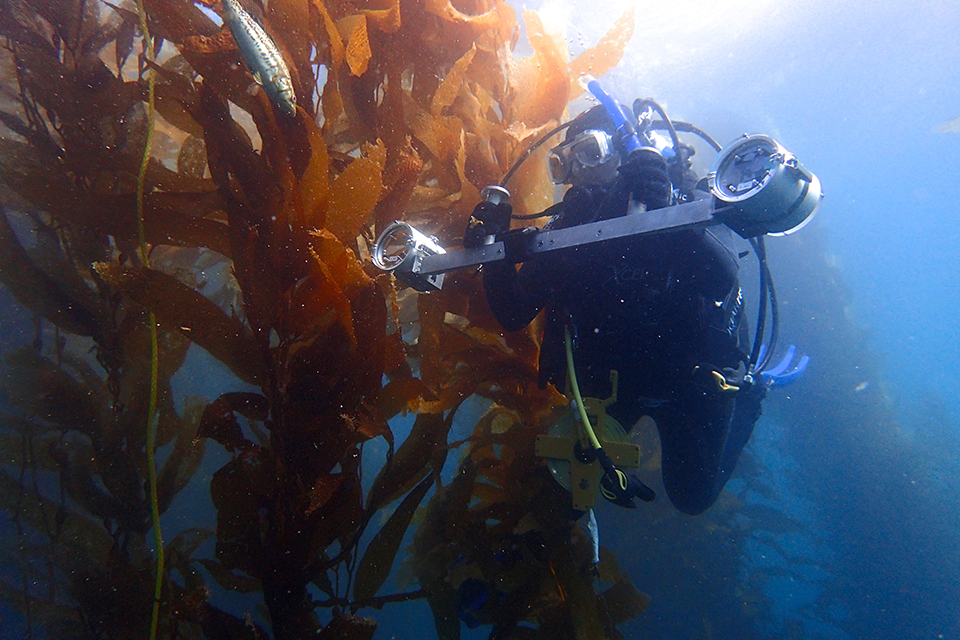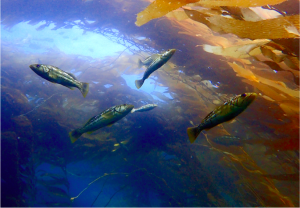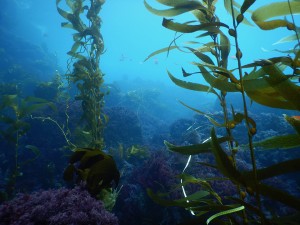CSUN Study Demonstrates Marine Protected Areas Are Most Effective in Overfished Areas

CSUN marine biologist Mark Steele and former graduate student Erin Jaco demonstrated that MPAs are particularly effective in restoring marine life in formerly heavily fished areas. The researchers used a diver-operated stereo-video camera system to document fish life in seven marine protected areas in a region known as the Southern California Bight. Photo by Hannah Nelson.
It is a logical assumption: California’s marine protected areas (MPAs) are most effective when they are placed in heavily fished regions. But few studies have been done to actually demonstrate this, until now.
California State University, Northridge marine biologist Mark Steele and former graduate student Erin Jaco spent more than two years carefully studying the fish populations in seven marine protected areas along the Southern California coast. What they found confirms what conservationists and marine biologists have long suspected — MPAs are particularly effective in restoring marine life in formerly heavily fished areas.
“There is a lot of work that goes into implementing MPAs — there are over 100 in the state of California alone — and it is important that government officials and conservationists take into account the effectiveness the MPAs have on heavily fished areas when compared to those areas where little fishing has occurred,” said Jaco, who graduated from CSUN in December 2018 with a master’s degree in biology with an emphasis in marine biology. She is lead author of the study.

Steele and Jaco Steele and Jaco argue that heavily fished areas should be target areas for MPA placement if the goal is to maximize ecological recovery. Photo by Hannah Nelson.
“When a heavily fished area is declared an MPA, you are giving a chance to the fish in that area to thrive and grow, which in turn means that marine life in the waters adjacent to that area also have a chance to thrive and grow,” she said.
Jaco’s and Steele’s findings, “Pre-closure fishing pressure predicts effects of marine protected areas,” were published today in the Journal of Applied Ecology.
The researchers used a diver-operated stereo-video camera system to document fish life in seven marine protected areas in a region known as the Southern California Bight, the curved coastline that stretches from Point Conception to San Diego and includes the Channel Islands. They compared that information with data on fishing pressure on those same regions before they were designated MPAs.
Jaco and Steele focused specifically on two species of fish that are popular with recreational fishermen — kelp bass and California sheephead. Kelp bass can only be fished recreationally in California and, despite the lack of commercial fishing pressure, the number of this species has declined by 90 percent since 1980 because of overfishing. As for California sheephead, Steele noted that previous studies have shown that overfishing has impacted that species’ size and caused it to mature at smaller sizes.
Steele said the health of an area of the ocean is not just measured in the amount of marine life in that particular region, but also the size and age of marine animals in that area.
“The rules for recreational fishing set minimum sizes of the fish people can catch,” Steele said. “But once an area becomes a popular spot for recreational fishermen, that area can become adversely impacted as the older, larger fish are caught, leaving behind smaller, younger fish that reproduce less than older fish.

The researchers point out that ecological improvements in MPAs spill over into surrounding waters. Photo By Erin Jaco
“It’s pretty simple,” he added, “the bigger the fish, the more babies are born.”
Steele and Jaco argue in their study that “while there is a benefit to preserving systems that are not heavily fished as insurance against future exploitation, heavily fished areas should be target areas for MPA placement if the goal is to maximize ecological recovery.”
“Communities always have a favorite fishing spot,” Jaco said. “This study helps make a case that if you want the quickest ecological recovery for an area — to bring the fish population back to a healthy level — then maybe an MPA should be put there. It’s an argument that has been made before, but now conservationists and government officials have scientific evidence to back up their argument. By using our findings, a strategy could be developed that balances the need to account for public opinion, while still deriving the benefits of an MPA.”
Steele pointed out that MPAs are not “fenced-in” areas in the ocean.
“They are actually longitude and latitude coordinates, and the boundaries are published where responsible boaters can see them,” he said. “If we are able to make ecological improvements in those protected areas, there are no solid boundaries, no concrete walls or fences, that prevent those positive effects from spilling over into nearby waters. And that benefits all of us.”

 experience
experience